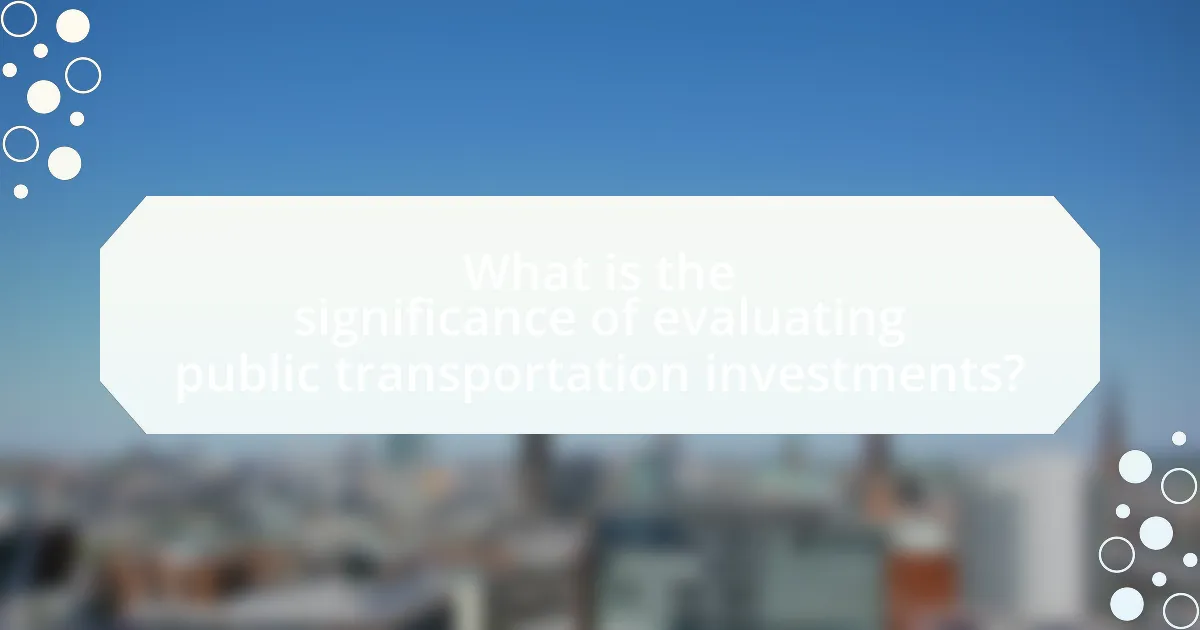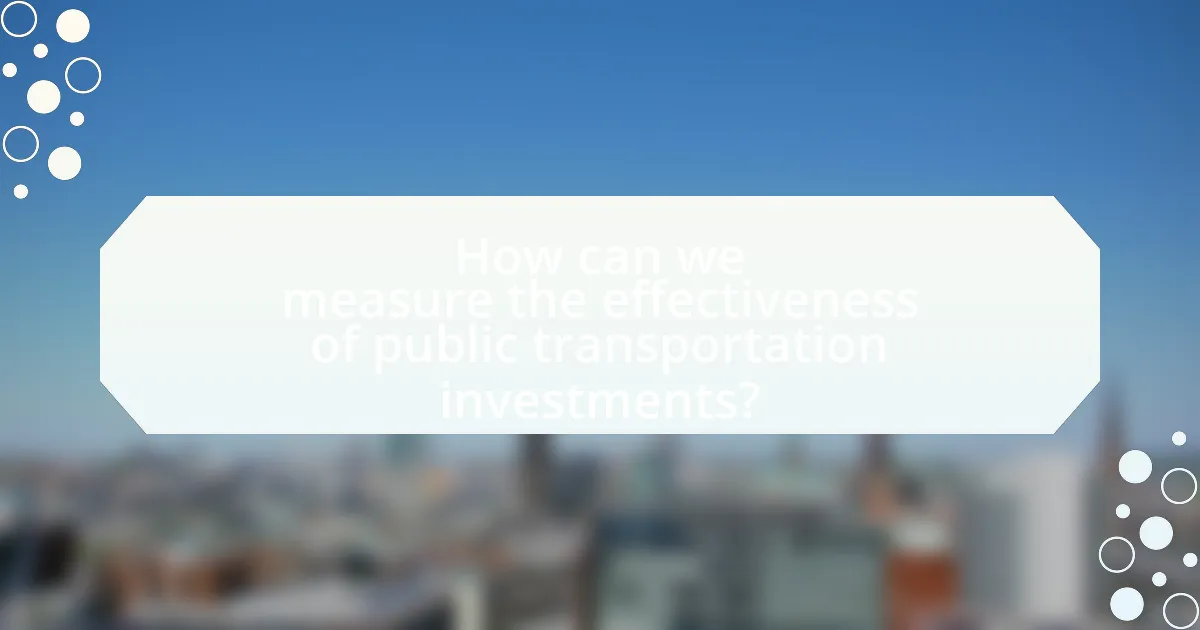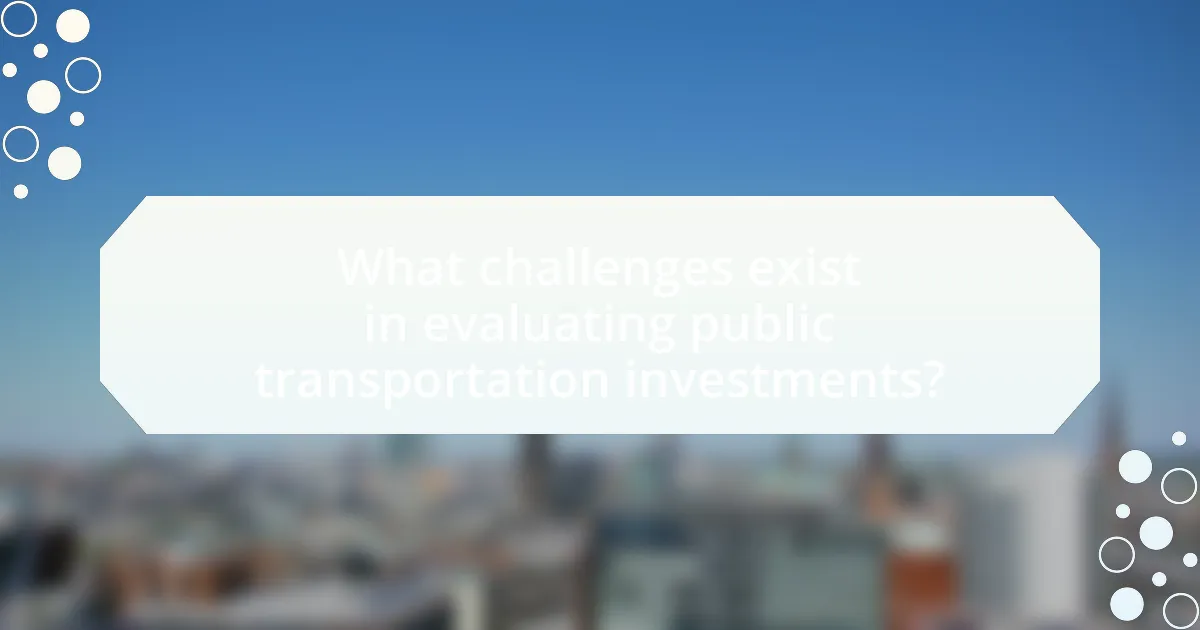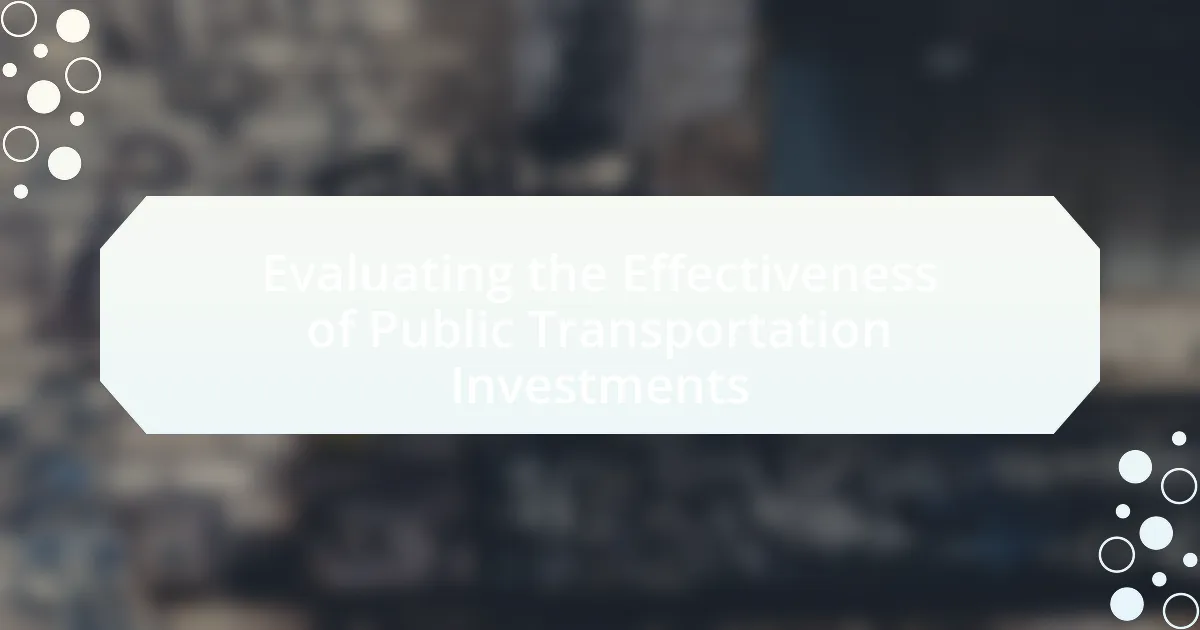Evaluating the effectiveness of public transportation investments is crucial for ensuring efficient resource allocation and maximizing societal benefits. This article examines the significance of such evaluations, highlighting key metrics like ridership levels, cost-effectiveness, and user satisfaction that inform decision-making in transportation planning. It discusses the objectives of public transportation investments, including enhancing mobility, reducing congestion, and promoting economic development, while also addressing the challenges faced in the evaluation process. Furthermore, it outlines best practices and methodologies for effective evaluation, emphasizing the importance of stakeholder collaboration and community engagement in achieving successful public transportation outcomes.

What is the significance of evaluating public transportation investments?
Evaluating public transportation investments is significant because it ensures efficient allocation of resources and maximizes societal benefits. By assessing factors such as cost-effectiveness, ridership levels, and environmental impact, stakeholders can make informed decisions that enhance mobility, reduce congestion, and promote sustainable development. For instance, a study by the American Public Transportation Association found that every $1 invested in public transportation generates approximately $4 in economic returns, highlighting the importance of thorough evaluation in optimizing investment outcomes.
Why is it important to assess the effectiveness of public transportation investments?
Assessing the effectiveness of public transportation investments is crucial for ensuring optimal allocation of resources and maximizing societal benefits. Effective evaluation allows policymakers to identify successful projects, understand user needs, and improve service delivery. For instance, a study by the American Public Transportation Association found that every $1 invested in public transit generates approximately $4 in economic returns, highlighting the importance of evaluating these investments to enhance economic growth and community development.
What metrics are commonly used to evaluate public transportation effectiveness?
Common metrics used to evaluate public transportation effectiveness include ridership levels, on-time performance, service frequency, customer satisfaction, and cost efficiency. Ridership levels indicate the number of passengers using the service, which reflects its popularity and accessibility. On-time performance measures the punctuality of services, essential for reliability. Service frequency assesses how often vehicles arrive, impacting convenience for users. Customer satisfaction surveys provide insights into user experiences and perceptions, while cost efficiency evaluates the financial sustainability of the service relative to its operational costs. These metrics collectively offer a comprehensive view of public transportation effectiveness, supported by studies indicating that higher ridership correlates with improved service quality and user satisfaction.
How do these metrics impact decision-making in transportation planning?
Metrics significantly impact decision-making in transportation planning by providing quantifiable data that informs resource allocation and project prioritization. For instance, metrics such as ridership numbers, cost-effectiveness ratios, and service reliability directly influence which transportation projects receive funding and attention. According to the American Public Transportation Association, a 10% increase in public transit ridership can lead to a 4% reduction in traffic congestion, demonstrating how metrics guide planners in optimizing transit systems to alleviate urban traffic issues. Furthermore, metrics enable planners to assess the environmental impact of transportation investments, ensuring that decisions align with sustainability goals. Thus, the use of precise metrics is essential for effective and informed transportation planning.
What are the key objectives of public transportation investments?
The key objectives of public transportation investments are to enhance mobility, reduce traffic congestion, promote environmental sustainability, and stimulate economic development. Enhancing mobility ensures that individuals have access to essential services and employment opportunities, which is crucial for urban development. Reducing traffic congestion leads to shorter travel times and improved quality of life for residents. Promoting environmental sustainability is achieved by decreasing reliance on personal vehicles, thereby lowering greenhouse gas emissions and improving air quality. Finally, stimulating economic development occurs through job creation and increased accessibility to businesses, which can lead to higher local revenues. These objectives are supported by studies indicating that effective public transportation systems can significantly improve urban living conditions and economic performance.
How do public transportation investments aim to improve accessibility?
Public transportation investments aim to improve accessibility by enhancing the availability and reliability of transit services for all individuals, including those with disabilities and low-income populations. These investments often include the construction of new transit lines, the expansion of service hours, and the implementation of features such as low-floor buses and accessible stations. For instance, the Federal Transit Administration reported that investments in accessible transit options have led to increased ridership among people with disabilities, demonstrating a direct correlation between funding and improved access. Additionally, studies show that cities that prioritize public transportation accessibility experience reduced transportation barriers, fostering greater social inclusion and economic opportunities for marginalized communities.
What role do public transportation investments play in economic development?
Public transportation investments significantly enhance economic development by improving accessibility, reducing travel times, and fostering job creation. These investments facilitate the movement of people and goods, which is essential for local businesses to thrive. For instance, a study by the American Public Transportation Association found that every $1 invested in public transportation generates approximately $4 in economic returns, highlighting the multiplier effect of such investments on local economies. Additionally, improved public transit systems can attract new businesses and residents, further stimulating economic growth in urban areas.

How can we measure the effectiveness of public transportation investments?
The effectiveness of public transportation investments can be measured through various metrics, including ridership levels, cost-effectiveness, and user satisfaction. Ridership levels indicate the number of passengers using the service, which reflects its popularity and utility; for instance, a 2019 report from the American Public Transportation Association showed that public transit ridership in the U.S. reached 9.9 billion trips, highlighting the importance of these investments. Cost-effectiveness can be assessed by comparing the operational costs to the benefits generated, such as reduced traffic congestion and lower emissions; studies have shown that every $1 invested in public transit generates approximately $4 in economic returns. User satisfaction surveys provide qualitative data on the perceived quality of service, which can be correlated with ridership trends. Collectively, these metrics offer a comprehensive view of the impact and effectiveness of public transportation investments.
What methodologies are used to evaluate public transportation projects?
Public transportation projects are evaluated using methodologies such as cost-benefit analysis, multi-criteria analysis, and impact assessment. Cost-benefit analysis quantifies the economic efficiency of a project by comparing the total expected costs to the total expected benefits, often using metrics like net present value and internal rate of return. Multi-criteria analysis incorporates various qualitative and quantitative factors, allowing stakeholders to weigh different aspects such as environmental impact, social equity, and user satisfaction. Impact assessments, including environmental and social impact assessments, evaluate the potential effects of a project on the community and ecosystem, ensuring compliance with regulations and stakeholder concerns. These methodologies provide a comprehensive framework for decision-making and project justification in public transportation investments.
How do qualitative and quantitative methods differ in evaluating effectiveness?
Qualitative and quantitative methods differ significantly in evaluating effectiveness by focusing on different types of data and analysis. Qualitative methods emphasize subjective insights, exploring experiences and perceptions through interviews, focus groups, and observations, which provide depth and context to the evaluation. In contrast, quantitative methods rely on numerical data and statistical analysis, measuring effectiveness through metrics such as ridership numbers, cost-benefit ratios, and survey results, allowing for generalizable conclusions. For instance, a study by the American Public Transportation Association found that quantitative metrics like ridership statistics can indicate overall system performance, while qualitative feedback from users can highlight specific areas for improvement, demonstrating the complementary nature of both approaches in assessing public transportation investments.
What are the advantages and disadvantages of different evaluation methodologies?
Different evaluation methodologies for public transportation investments have distinct advantages and disadvantages. Quantitative methodologies, such as cost-benefit analysis, provide clear numerical data that can facilitate decision-making and demonstrate economic viability. However, they may overlook qualitative factors, such as user satisfaction and social equity. Qualitative methodologies, like stakeholder interviews, capture these nuanced perspectives but can be subjective and harder to generalize. Mixed-method approaches combine both quantitative and qualitative data, offering a comprehensive view but may require more resources and time to implement effectively. Each methodology’s effectiveness depends on the specific context and objectives of the evaluation.
What case studies illustrate successful evaluations of public transportation investments?
Case studies that illustrate successful evaluations of public transportation investments include the Portland MAX Light Rail system and the Los Angeles Metro Rail expansion. The Portland MAX Light Rail, which began operations in 1986, has been associated with a 20% increase in transit ridership and significant economic development along its corridors, demonstrating a strong return on investment. Similarly, the Los Angeles Metro Rail expansion, particularly the Expo Line, has shown a 10% increase in ridership and has spurred over $1 billion in new development along its route, validating the effectiveness of the investment in enhancing public transportation and stimulating local economies.
What lessons can be learned from successful public transportation projects?
Successful public transportation projects demonstrate the importance of comprehensive planning and community engagement. Effective projects often involve extensive stakeholder consultation, ensuring that the needs and preferences of the community are prioritized, which leads to higher ridership and satisfaction. For example, the implementation of the Portland MAX Light Rail system involved significant public input, resulting in a service that effectively meets local demand and has seen ridership increase by over 50% since its inception. Additionally, successful projects emphasize the integration of various transportation modes, enhancing connectivity and convenience for users. The San Francisco Bay Area’s BART system exemplifies this by linking trains, buses, and ferries, facilitating seamless travel across the region. These lessons highlight that successful public transportation initiatives require a focus on community needs and multimodal integration to achieve effectiveness and sustainability.
How have evaluations influenced future public transportation investments?
Evaluations have significantly influenced future public transportation investments by providing data-driven insights that guide funding decisions and project prioritization. For instance, comprehensive assessments of existing transit systems, such as the Federal Transit Administration’s evaluation of the New Starts program, have highlighted successful projects and identified areas needing improvement, leading to more strategic allocation of resources. Additionally, evaluations often incorporate community feedback and performance metrics, ensuring that investments align with public needs and enhance overall system efficiency. This evidence-based approach has resulted in increased funding for high-performing projects and a shift away from less effective initiatives, ultimately shaping the future landscape of public transportation.

What challenges exist in evaluating public transportation investments?
Evaluating public transportation investments faces several challenges, primarily due to the complexity of measuring their impacts. One significant challenge is the difficulty in quantifying benefits such as reduced congestion, improved air quality, and enhanced accessibility, which are often intangible and long-term. Additionally, the lack of standardized metrics for comparison across different projects complicates the evaluation process. For instance, a study by the Transportation Research Board highlights that variations in local contexts and project scopes can lead to inconsistent data, making it hard to draw definitive conclusions about effectiveness. Furthermore, political and social factors can influence investment decisions and evaluations, leading to biases that may skew results. These challenges collectively hinder a comprehensive assessment of public transportation investments.
What are the common obstacles faced during the evaluation process?
Common obstacles faced during the evaluation process of public transportation investments include data availability, stakeholder engagement, and methodological challenges. Data availability is often limited due to insufficient or outdated information, which hinders accurate assessments. Stakeholder engagement can be problematic as differing interests and priorities among community members, government agencies, and private entities may lead to conflicts and delays. Methodological challenges arise from the complexity of measuring impacts, such as quantifying benefits like reduced congestion or improved accessibility, which require sophisticated analytical techniques. These obstacles collectively impede the effectiveness of evaluations, making it difficult to draw reliable conclusions about the success of public transportation investments.
How do funding limitations affect the evaluation of public transportation investments?
Funding limitations significantly hinder the evaluation of public transportation investments by restricting the scope and depth of analysis. When financial resources are scarce, evaluators may prioritize short-term outcomes over comprehensive assessments, leading to incomplete data collection and analysis. For instance, a study by the Transportation Research Board indicates that limited funding often results in reliance on less rigorous evaluation methods, which can overlook critical long-term benefits such as reduced congestion and environmental impacts. Consequently, this can skew decision-making processes and hinder the ability to justify future investments in public transportation systems.
What role does public perception play in the evaluation process?
Public perception significantly influences the evaluation process of public transportation investments. Stakeholders, including policymakers and funding agencies, often rely on public opinion to gauge the success and effectiveness of transportation projects. For instance, positive public perception can lead to increased funding and support for future initiatives, while negative perceptions may result in project delays or cancellations. Research indicates that community engagement and satisfaction surveys are critical in assessing public sentiment, which directly impacts the perceived value and effectiveness of transportation investments.
How can stakeholders improve the evaluation of public transportation investments?
Stakeholders can improve the evaluation of public transportation investments by implementing comprehensive data collection and analysis methods. By utilizing advanced analytics and real-time data, stakeholders can assess ridership patterns, operational efficiency, and user satisfaction more effectively. For instance, the Federal Transit Administration emphasizes the importance of performance metrics, such as cost per passenger mile and service reliability, which provide concrete evidence of investment impacts. Additionally, engaging with community feedback through surveys and public forums allows stakeholders to incorporate diverse perspectives, ensuring that evaluations reflect actual user experiences and needs. This multifaceted approach leads to more informed decision-making and enhances the overall effectiveness of public transportation investments.
What best practices can be implemented for effective evaluation?
Best practices for effective evaluation of public transportation investments include establishing clear objectives, utilizing comprehensive data collection methods, and engaging stakeholders throughout the evaluation process. Clear objectives ensure that the evaluation aligns with specific goals, such as improving ridership or reducing travel times. Comprehensive data collection methods, including surveys, ridership statistics, and cost-benefit analyses, provide a robust foundation for assessing impacts. Engaging stakeholders, such as community members and transportation agencies, fosters transparency and ensures that diverse perspectives are considered, enhancing the evaluation’s relevance and accuracy. These practices are supported by research indicating that structured evaluations lead to more informed decision-making and improved outcomes in public transportation projects.
How can collaboration among stakeholders enhance evaluation outcomes?
Collaboration among stakeholders enhances evaluation outcomes by integrating diverse perspectives and expertise, leading to more comprehensive assessments. When stakeholders such as government agencies, community organizations, and transportation experts work together, they can identify key performance indicators that reflect the needs of various groups, ensuring that evaluations are relevant and actionable. For instance, a study by the Transportation Research Board found that collaborative evaluations in public transportation projects resulted in a 30% increase in stakeholder satisfaction and a 25% improvement in project implementation effectiveness. This evidence demonstrates that stakeholder collaboration not only enriches the evaluation process but also leads to more successful public transportation investments.
What practical tips can be applied to enhance the effectiveness of public transportation investments?
To enhance the effectiveness of public transportation investments, prioritize integrated planning that aligns transportation projects with land use and community needs. This approach ensures that investments are made in areas with high demand for transit services, thereby increasing ridership and efficiency. For instance, cities that have adopted transit-oriented development strategies, such as Portland, Oregon, have seen significant increases in public transport usage, with a reported 30% rise in ridership in areas near new transit lines. Additionally, implementing real-time data systems can improve service reliability and customer satisfaction, as evidenced by cities like San Francisco, where the introduction of real-time tracking led to a 15% increase in on-time performance.

Leave a Reply